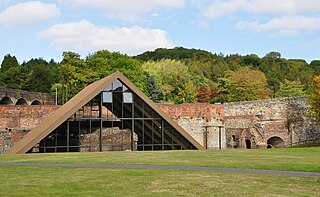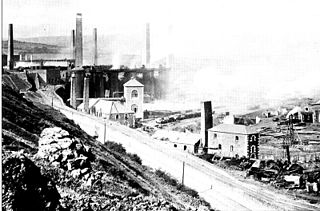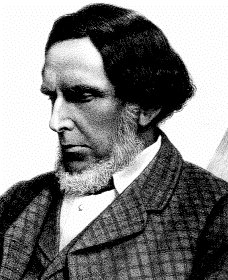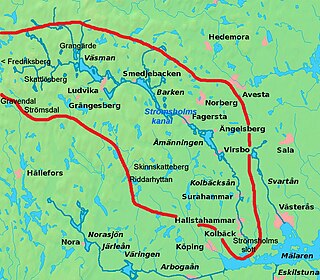Related Research Articles

The Black Country is an area of England's Midlands. It is mainly urban, covering most of the Dudley, Sandwell and Walsall Metropolitan Boroughs, with the City of Wolverhampton sometimes included. The towns of Dudley and Tipton are generally considered to be the centre.

Blaenavon is a town and community in Torfaen county borough, Wales, high on a hillside on the source of the Afon Lwyd. It is within the boundaries of the historic county of Monmouthshire and the preserved county of Gwent. The population is 6,055.

Coalbrookdale is a village in the Ironbridge Gorge and the Telford and Wrekin borough of Shropshire, England, containing a settlement of great significance in the history of iron ore smelting. It lies within the civil parish called the Gorge.

The Wealden iron industry was located in the Weald of south-eastern England. It was formerly an important industry, producing a large proportion of the bar iron made in England in the 16th century and most British cannon until about 1770. Ironmaking in the Weald used ironstone from various clay beds, and was fuelled by charcoal made from trees in the heavily wooded landscape. The industry in the Weald declined when ironmaking began to be fuelled by coke made from coal, which does not occur accessibly in the area.

Henry Cort was an English ironware producer who was formerly a Navy pay agent. During the Industrial Revolution in England, Cort began refining iron from pig iron to wrought iron using innovative production systems. In 1784, he obtained a patent for an improved version of Peter Onions's puddling process, for refining cast iron, although its commercial viability was only realised in the 1790s, through further innovations introduced by Richard Crawshay and Homfray of the Cyfarthfa Ironworks, in Merthyr Tydfil.

Blaenavon Industrial Landscape, in and around Blaenavon, Torfaen, Wales, was inscribed a World Heritage Site by UNESCO in 2000. The Blaenavon Ironworks, now a museum, was a major centre of iron production using locally mined or quarried iron ore, coal and limestone. Raw materials and products were transported via horse-drawn tramroads, canals and steam railways. The Landscape includes protected or listed monuments of the industrial processes, transport infrastructure, workers' housing and other aspects of early industrialisation in South Wales.

Shelton Bar was a 400-acre (1.6 km2) major steelworks in the city of Stoke-on-Trent, Staffordshire, England. In its heyday, Shelton Bar employed 10,000 in the steelworks, had five coal mines, a complete railway system, and a by-products processing factory.

The Cyfarthfa Ironworks were major 18th- and 19th-century ironworks in Cyfarthfa, on the north-western edge of Merthyr Tydfil, in South West Wales.
Basford is a suburb which sits on high ground between Newcastle-under-Lyme and Stoke-on-Trent in Staffordshire, England.

Robert Forester Mushet was a British metallurgist and businessman, born on 8 April 1811, in Coleford, in the Forest of Dean, Gloucestershire, England. He was the youngest son of Scottish parents, Agnes Wilson and David Mushet; an ironmaster, formerly of the Clyde, Alfreton and Whitecliff Ironworks.

The Round Oak Steelworks was a steel production plant in Brierley Hill, West Midlands, England. It was founded in 1857 by Lord Ward, who later became, in 1860, The 1st Earl of Dudley, as an outlet for pig iron made in the nearby blast furnaces. During the Industrial Revolution, the majority of iron-making in the world was carried out within 32 kilometres of Round Oak. For the first decades of operation, the works produced wrought iron. However, in the 1890s, steelmaking was introduced. At its peak, thousands of people were employed at the works. The steelworks was the first in the United Kingdom to be converted to natural gas, which was supplied from the North Sea. The works were nationalized in 1951, privatized in 1953 and nationalized again in 1967 although the private firm Tube Investments continued to part manage the operations at the site. The steelworks closed in December 1982.

Blaenavon Ironworks is a former industrial site which is now a museum in Blaenavon, Wales. The ironworks was of crucial importance in the development of the ability to use cheap, low quality, high sulphur iron ores worldwide. It was the site of the experiments by Sidney Gilchrist Thomas and his cousin Percy Gilchrist that led to "the basic steel process" or "Gilchrist–Thomas process".

Darkhill Ironworks, and the neighbouring Titanic Steelworks, are internationally important industrial remains associated with the development of the iron and steel industries in the 19th century. Both are scheduled monuments. They are located on the edge of a small hamlet called Gorsty Knoll, just to the west of Parkend, in the Forest of Dean, Gloucestershire, England. Historically, Darkhill was sometimes written Dark Hill.

Ecomuseum Bergslagen is an open-air museum in the western part of the former mining and smelting region of Bergslagen in central Sweden. The museum opened in 1986 and is today the world's largest ecomuseum. The museum is a joint project of the municipalities Ludvika, Smedjebacken, Fagersta, Norberg, Skinnskatteberg, Surahammar and Hallstahammar. Two provincial museums in Dalarna and Västmanland County participate in the project. In 1998 Ecomuseum Bergslagen was awarded as the best industrial history museum in Europe with the Luigi Micheletti Award.
Boaz Bloomer JP was a prominent industrialist from Holly Hall in Dudley, Worcestershire, England, who lived between 1801 and 1874. He owned and operated the Pelsall Ironworks, among other ventures, during the 19th Century. He died in Kensington, Middlesex.
"The Diamond Maker" is a short story by H. G. Wells, first published in 1894 in the Pall Mall Budget. It was included in The Stolen Bacillus and Other Incidents, the first collection of short stories by Wells, published in 1895.
John Bradley & Co was a company established in 1800 by John Bradley at Stourbridge in the West Midlands area of England. The company developed into a large industrial concern with furnaces, ironworks and mines. Under James Foster, John Bradley's half brother, it was instrumental in bringing the first commercial steam locomotive into the Midlands area in 1829. The firm stayed under family control until the early years of the 20th century when first the mining (1913) and then the ironworks (1919) were sold off. Part of the business continued to trade under the name John Bradley & Co. (Stourbridge) Ltd until after the Second World War.

The Lithgow Blast Furnace is a heritage-listed former blast furnace and now park and visitor attraction at Inch Street, Lithgow, City of Lithgow, New South Wales, Australia. It was built from 1906 to 1907 by William Sandford Limited. It is also known as Eskbank Ironworks Blast Furnace site; Industrial Archaeological Site. The property is owned by Lithgow City Council. It was added to the New South Wales State Heritage Register on 2 April 1999.
John Gibbons was a South Staffordshire ironmaster and art patron.

British industrial architecture has been created, mainly from 1700 onwards, to house industries of many kinds in Britain, home of the Industrial Revolution in this period. Both the new industrial technologies and industrial architecture soon spread worldwide. As such, the architecture of surviving industrial buildings records part of the history of the modern world.
References
- 1 2 John R. Hammond (22 July 2014). A Preface to H G Wells. Routledge. pp. 90–. ISBN 978-1-317-87701-1.
- ↑ H. G. Wells writer stayed in this house during the year 1888. Open Plaques, accessed 12 May 2016.
- ↑ Wells, H. G. (1934). "Chapter the Sixth: Struggle for a Living". Experiment in Autobiography. Archived from the original on 25 October 2017.
- ↑ The Cone title listing at the Internet Speculative Fiction Database, accessed 15 August 2015.